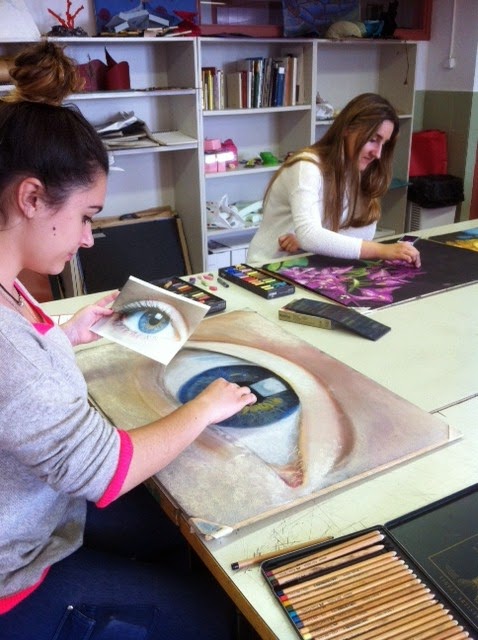Legend of Lead Pencil.
why pencil cores are called “lead”, even though they don’t contain lead??
In the 16th century, a large deposit of pure, solid graphite was discovered in Borrowdale, England. This was the first time in recorded history that high quality, solid graphite had been found. When metallurgists first encountered this substance, they thought it was some sort of black lead, rather than a form of carbon. Thus, they called it “plumbago”, which is derived from “plumbum”, which is Latin for “lead”.
It didn’t take people long to realize that solid sticks of high quality graphite were good for marking things. At that point, this newly discovered substance from the mines of Borrowdale became extremely valuable. So much so that guards were eventually posted at the entrance to the mine and laws were passed to stop people from stealing the solid graphite. In addition, once a sufficient stock of the graphite was mined, the mine itself would be flooded until more graphite was needed.
Unfortunately, sticks of pure graphite are fairly brittle, so people started embedding it in various things such as hollowed out pieces of wood and also simply wrapped tightly in sheep skin. Thus, the pencil was officially born with a core of solid graphite, which was known then as black lead. The tradition of calling sticks of graphite “lead” has endured to this day.
We have been working with graphite pencils, using an enlarging grid and a black and white picture of a lion, learning how true artists draw shadows and light...and it's been really difficult!!!
We hope you like it!

Benviguts al blog d'artístic de Jesuïtes Gràcia-Col·legi Kostka. Aquí hi podreu veure una selecció dels treballs que fem a les diferents matèries d'artístic. A la part dreta d'aquest blog, hi trobareu el llistat de les webs dels nostres alumnes on hi mostren una selecció dels seus treballs. Esperem que us agradi!
divendres, 28 de març del 2014
DRY TECHNIQUE: LEAD PENCIL
Etiquetes de comentaris:
arts&crafts,
Barcelona,
Escola Kostka,
Jesuïtes Gràcia,
Plàstica Kostka,
VIP1
DIBUIX A PASTEL
DIBUIX A PASTEL
Els alumnes de
Dibuix Artístic de 2n de Batxillerat
d’Arts hem estat treballant les nostres pròpies obres amb la tècnica del
pastel i llapis de colors en format de 50x70 cm.
La Nerea ha
treballat a partir d’una fotografia seva d’una flor groga. En Max ha volgut
copiar una fotografia on hi surt ell
contemplant un paisatge d’Irlanda. La Paula ha volgut inspirar-se d’un fragment
d’una poesia d’amor. L’Astrid ha volgut dibuixar l’ull de la seva mare i l’Anna
ha dibuixat una fotografia que va fer ella d’unes bogambílies. Oi que són moooooolt
xulos?
 |
| NEREA CANO |
 |
| ÁLEX GRANDE |
 |
| ANNA MARÍN |
 |
| MAX HERNÁNDEZ |
 |
| PAULA GARCÍA |
Aquí us mostrem com treballàvem a classe aquests dibuixos.
dijous, 13 de març del 2014
MAQUETA "JARDÍ"
L'espai és un element aparentment abstracte, mesurable però immaterial. En la majoria de casos allò que
anomenem espai és un element que nosaltres generem o, per ser més exactes, que fem visible a través
de les construccions tridimensionals: instal·—lant elements, unint formes, posant límits… És a dir que podem crear espais.
Per entendre millor aquest concepte de creació d'espais i fer una aproximació al món del disseny d'espais, elaborem una primera maqueta, anomenada "Jardí", la qual ha de complir les següents condicions: ha d'aparèixer-hi un camí i tots els elements utilitzats per a la realització de la maqueta han de ser naturals.
Aquí en tenim unes quantes mostres:
Andrea Serdà Cristina Llop


anomenem espai és un element que nosaltres generem o, per ser més exactes, que fem visible a través
de les construccions tridimensionals: instal·—lant elements, unint formes, posant límits… És a dir que podem crear espais.
Per entendre millor aquest concepte de creació d'espais i fer una aproximació al món del disseny d'espais, elaborem una primera maqueta, anomenada "Jardí", la qual ha de complir les següents condicions: ha d'aparèixer-hi un camí i tots els elements utilitzats per a la realització de la maqueta han de ser naturals.
Aquí en tenim unes quantes mostres:
Andrea Serdà Cristina Llop

Helena Corominas Clàudia Cela

Etiquetes de comentaris:
Barcelona,
Batxillerat Artístic,
Escola Kostka,
Jesuïtes Gràcia,
Volum
FIGURES DE SABÓ
Una escultura volumètrica es pot treballar, bàsicament, a través de la substracció o talla de material o bé a l'inrevés: a través del modelatge o afegiment de material.
En aquest cas, els alumnes de 1r de Batxillerat han estat experimentant la precisió, cura i detall de la tècnica de la talla amb pastilles de sabó. La temàtica i les eines a utilitzar eren lliures i els resultats han estat els següents:
Andrea Feliu Clàudia Cela

Andrea Feliu Clàudia Cela
Cristina Llop Andrea Serdà
Pablo Camacho Helena Corominas

Etiquetes de comentaris:
Barcelona,
Batxillerat Artístic,
Escola Kostka,
Jesuïtes Gràcia,
Volum
Subscriure's a:
Comentaris (Atom)
























